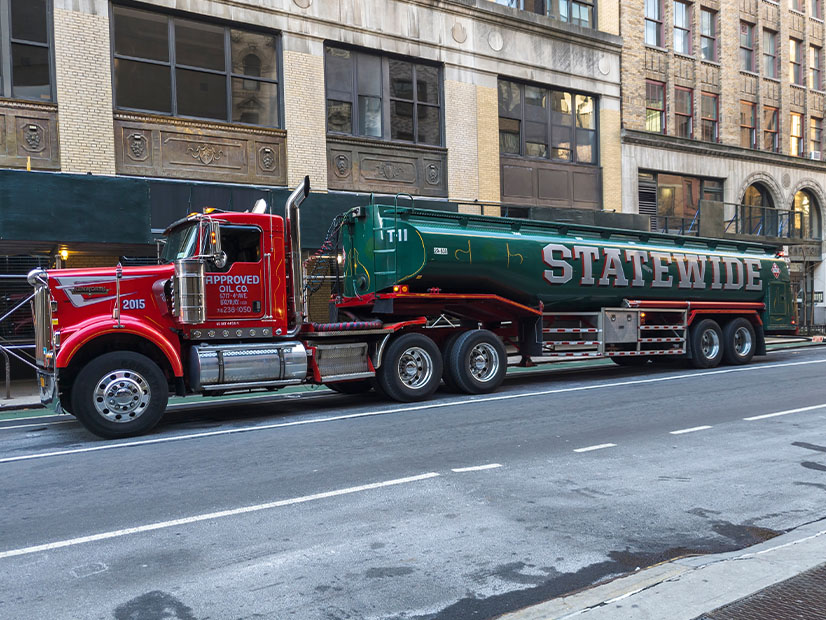
Dueling visions for New York’s proposed cap-and-invest system are being offered as state officials continue the lengthy process of codifying its details.
Environmental advocates, alarmed by the state’s lagging progress toward its decarbonization goals, are calling for a robust scheme to be put in place as soon as possible.
Business, labor and industry representatives, alarmed by the escalating, yet still unknown costs of those decarbonization efforts, are calling for a pause to assess what realistically is possible and affordable in New York.
Both statements were issued July 30 and are keyed to the fifth anniversary of the state’s landmark Climate Leadership and Community Protection Act, signed into law in 2019.
The CLCPA mandates a 40% reduction of greenhouse gas emissions by 2030 over 1990 levels and an 85% reduction by 2050. Cap-and-invest is intended to incentivize carbon-emitting industries to reduce their emissions.
The CLCPA scoping plan finalized in December 2022 recommended the cap-and-invest system as one way to help achieve those goals.
Gov. Kathy Hochul (D) announced details of a cap-and-invest concept in early 2023.
The state Department of Environmental Conservation and the New York State Energy Research and Development Authority are developing the proposal. It still is a pre-proposal, having reached Stage 4 of an eight-step process that already has generated nearly 5,000 public comments.
Meanwhile, the clock is ticking.
NYSERDA and the state Public Service Commission on July 1 issued a draft report saying the state would miss the CLCPA target of 70% renewable energy by 2030, perhaps by a wide margin, thanks to a variety of factors both local and global. (See NY Expects to Miss 2030 Renewable Energy Target.)
An audit released July 17 by the Office of State Comptroller made the same point, and faulted the state for offering no estimate of what the overall effort would cost, or how much of that cost would fall on utility customers who already have some of the highest rates in the country. (See Audit Faults NY on Climate Act Progress.)
These delays and costs were cited in the competing wish lists issued July 30.
The Environmental Defense Fund and 28 like-minded organizations urged Hochul to advance an ambitious set of regulations as soon as possible:
“The health and safety of our communities and of future generations depends on bold leadership and meaningful action to implement and fund our nation-leading climate law. Our organizations call on Governor Hochul to propose draft regulations for a cap-and-invest program that delivers on the promise and requirements of the CLCPA without further delay.”
Kate Courtin, senior manager of New York’s climate policy and strategy team, told NetZero Insider that “the pre-proposal is a helpful first step,” but advocates want a formal rulemaking to be put in place.
She said the cost concerns raised by opponents and skeptics miss the point — the cap-and-invest program should be viewed not in terms of its costs but the larger savings it will yield in the short and long term.
Cap-and-invest would provide economywide market signals and give the state money it could invest in the clean-energy transition, Courtin said.
“The reality right now is we’re just not investing enough,” she said.
Preliminary state analysis shows cap-and-invest would yield $6 billion to $12 billion a year in revenue. That would come from the industries generating the emissions, which presumably would pass the cost along to New Yorkers.
Hochul recently took a controversial step to cushion New Yorkers from the cost of the state’s climate-protection efforts, placing an indefinite pause on a congestion-pricing system meant to limit vehicle traffic in New York City.
Courtin said the call for expedited action by the environmental advocates was not in concern that a similar pause is in the works for cap-and-invest, but because the new program is taking too long to devise. Hochul’s initial proposal called for the regulations to be in place by the end of 2023.
But such a time-out is exactly what the Business Council of New York State would like to see. It and 61 other business, union and industrial organizations called on the state to make mid-course corrections to its implementation of the CLCPA, based on the significant economic and market changes seen since it became law.
The Business Council wrote:
“Since the start of the CLCPA implementation efforts five years ago, many have called for a more comprehensive, publicly accessible assessment of implementation costs, the comparative costs of policy alternative programs and the impact of new policies on residential and business energy consumers. We are renewing those demands today.”
It clarified that it is not criticizing the goals of the CLCPA.
“We are not opposing further state investments in emission reductions, renewable generation and energy efficiency, nor are we opposing the adoption of a ‘cap and invest’ program. However, the state needs to ensure that its push toward emission reductions and the electrification of major sectors are technically and economically achievable.”
The vision for cap-and-invest in New York goes beyond greenhouse gas emissions.
Its architects are charged with designing a program that simultaneously targets benefits to disadvantaged communities, channels money to New Yorkers to defray the higher costs that would accompany the program, invests in industries of the future and supports the transition to a less carbon-intensive economy.


